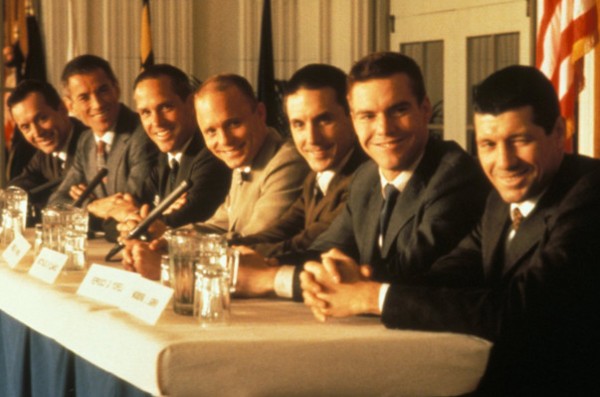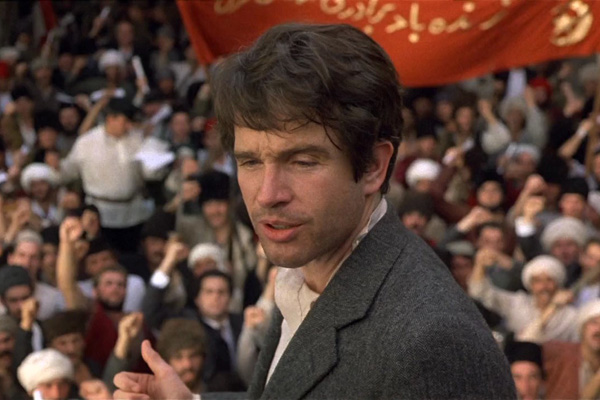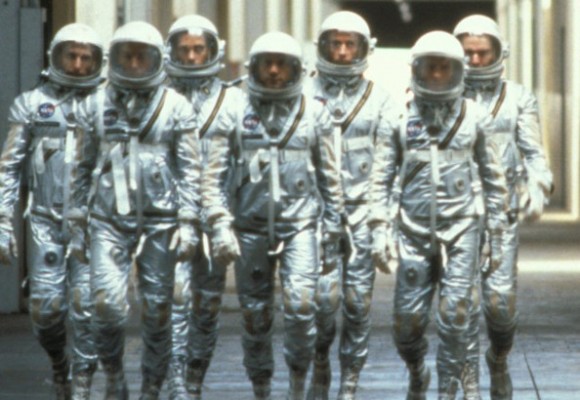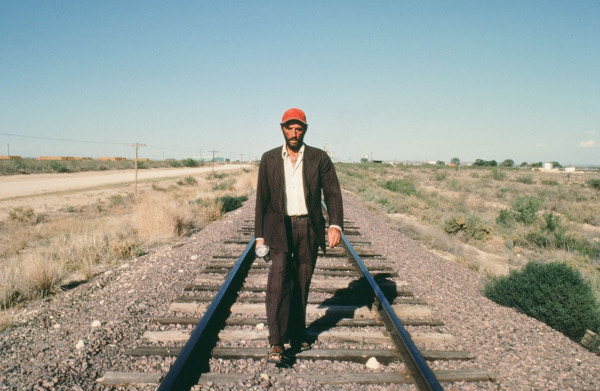The New Frontier, Same as the Old Frontier
Published in collaboration with Reverse Shot
The Right Stuff, Paris, Texas, and Reds are being shown at Museum of the Moving Image as part of the series See It Big!: The American Epic.
"We are too
great a nation to limit ourselves to small dreams… We have every right to dream
heroic dreams. Those who say that we're in a time when there are no heroes,
they just don't know where to look."—Ronald
Reagan’s First Inaugural Address, January 20, 1981
The received
wisdom about American cinema in the 1980s is that it was an artistically barren
time, a creative comedown after the “maverick” auteurist pinnacle of 1970s. The
seeds of blockbuster culture planted by Jaws and Star Wars grew into a
hegemonic forest of Spielberg, Lucas, Stallone, Schwarzenegger, Zemeckis, and
Reitman, and sequels upon sequels. It marked the end of personal cinema and
idiosyncratic artistry on a grand scale, ushering in the bifurcation between
Hollywood and independent cinema that persists today. The budgetary bloat and
reactionary ideology of the country’s cinema (Rambo, Red Dawn, etc)
neatly and tellingly harmonized with the country’s Reaganite politics. As David
Bordwell wrote in a defense of the decade in 2008: “Like big hair and padded shoulders and Wham!, the films
of the 1980s are apparently something to be ashamed of.”
Although much
of the above has traction in reality, the truth, as is truth’s wont, is more
complicated. For all of the corporate consolidation and crass opportunism, it
was also a time of big-stage, tough-sell passion projects—especially among
1970s-hewn auteurs who were undeterred by an industry supposedly inhospitable
to risk, from Spielberg’s Empire of the Sun to Scorsese’s The
Last Temptation of Christ, Coppola’s Tucker: The Man and His Dream, De
Palma’s Casualties of War, and
Lucas-Henson’s The Dark Crystal. Yes, there was Friday
the 13th Part VIII: Jason Takes Manhattan, but it was also a time when
David Lynch and David Cronenberg were entrusted with the biggest-budgeted
projects of their careers, and when incomparable masterpieces like Tootsie
and Full
Metal Jacket arrived irrespective of their Cineplex neighbors.
And it was
also a time when the contradictions and conflicts within both the industry and
the national ideology could themselves be explored on the big screen. The 1980s
were rife with cinematic Trojan horses that proved more troubling and complex
than their packaging, or pop cultural context, would indicate. Witness Warren
Beatty’s Reds (1981), a self-scrutinizing
romantic communist epic that, by turning up mere months after conservative
savior Ronald Reagan’s electoral landslide, is perhaps the most politically
countercultural Hollywood movie ever released; Philip Kaufman’s The
Right Stuff (1983), a shaggy-dog dissertation on our twinned
taste for individuality and collectivism disguised as a pro-NASA prestige
picture; and Wim Wenders’s Paris, Texas (1984), a road movie
melodrama that simultaneously dismantles and exults in the myth of the taciturn
Western hero, These three films in particular explored the dawn of the Reagan
era as a time for reimagining and reevaluating the American frontier—in borders
actual and imagined, ideological and metaphoric, collective and personal. To
scramble Reagan’s own words, they each interrogate our heroic dreams, and
honestly consider the costs of America’s “greatness.”

The Right Stuff
It may not be
the first genre that comes to mind when you think of the 1980s, but as with the
1950s—another deceptive era, usually deemed "reactionary"—three-hour historical epics had a
strong foothold throughout the decade, most notably with best picture Oscar
winners Gandhi and The Last Emperor. But though
The
Right Stuff and Reds certainly qualify as
epics—each was long enough to justify an intermission, and each spanned a
crucial era in 20th century history—they’re also exceptionally odd ducks,
formally frisky endeavors by radicals eager to torpedo whatever reverence the
venerable genre invites.
Reds may be
remembered in part for its bifurcated docu-dramatic storytelling gambit, but
thanks to the onscreen participation of Diane Keaton, Jack Nicholson, and
Warren Beatty himself, it’s easy to forget how pervasively into the narrative
are the film’s testimonials from real-life eyewitness. Far from just a framing
device, the interviews often spill into the scripted sequences, effectively
narrating and even motivating performance, mise-en-scène, and cinematographer
Vittorio Storaro’s camera.
The film is
similarly twinned—and blended—in terms of tone. The documentary footage starts
off as sober if engaging testimony, while the John Reed (Beatty)—Louise Bryant
(Keaton) story plays as a big screen romance, complete with witty repartee,
irresolvable jealousies and passions, and old Hollywood charisma thanks to the
rapid-fire elocution and self-effacing beauty of the leads. Beatty seems to
have resolved to have his cake and eat it too, seriously relating the
experiences of Yankee communists during the dawn of the Russian Revolution
while entertainingly presenting a continent-spanning love affair for the ages.
Yet just when it seems that tone will match form, the tenor of each shifts. A
gossipy levity creeps into the talking head clips, while the fictionalized
passages tilt into an invaluable dramatization of the ideological splintering
of the Left—as it relates to the Reed-Bryant relationship, but also to the evolution of progressive political
thought in the 20th century.
A final-act
confrontation between Beatty’s Reed and Maureen Stapleton’s Emma Goldman—two
Americans trapped in Moscow and by their own diverging ideologies—offers a
commendably complex distillation of how philosophy is warped, inevitably if not
necessarily, by the prospect of structural and political implementation. Reed
comes off as a rational defender of the Soviet Union’s moral compromises, and
Goldman as a stubborn dreamer absconding with the ugly complications of her
beliefs, yet history tells us that for all of its ends-justify-the-means
pragmatism, it’s the former that led to genocide.

Warren Beatty as John Reed in Reds
Yet Beatty
never gets hung up on foregrounding what would become of the Soviet experiment,
and never demonizes those involved. Considering he was working within the Cold
War, and specifically during a transition into Reaganite
saber rattling, such restraint was either heroic or seditious, depending on
one’s inclinations. In this respect, it’s the love affair that saves the film:
we get to feel the urgency and weight of ideological convictions as they play
out between two fully realized people whose passions are never condescended to,
and never fully commensurate with each other. From Portland to New York to
Provincetown to Moscow to a Finnish prison to the Middle East and back to
Moscow, they pursue their beliefs and each other, which in the end seem both
interchangeable and irreconcilable, and always worthwhile.
While
Beatty’s leftist narrative is threaded together by romance, Philip Kaufman’s
similarly sprawling adaptation of Tom Wolfe’s nonfiction novel The
Right Stuff, released two years later, is ironically the one preoccupied
by the notion of comradeship. Released the same year as Reagan’s so-called
“Star Wars” defense initiative, it is a Cold War film about an earlier phase of
the military industrial détente—the space race. Like Reds, Kaufman’s
Oscar-winner conveys historical sweep via chronological progression, beginning
with Chuck Yeager’s breaking of the sound barrier in 1947 and ending with Gordon
Cooper’s orbital flight around the earth in 1963. What would seem like a
straight-up stroke job for NASA turns out to be a far cooler affair, composer
Bill Conti’s Wagnerian triumphalism notwithstanding. Such is Kaufman’s aversion
to authority that every player who’s in a position of power or potential
advantage—i.e., everyone who’s not either a test pilot or the wife of a test
pilot—is subject to distrust and derision. This includes the head of the
Mercury program (John P. Ryan), the NASA recruiters (Harry Shearer and Jeff
Goldblum), Vice President Lyndon Baines Johnson (Donald Moffat), the
German-born physicists whose rockets and spacecrafts made space travel possible
(Scott Beach et al), the press corps paparazzi (the Fratelli Bologna Comedia
Dell’Arte group), assorted groupies and PR flacks, and even higher ranking
military personnel.
But it’s not
just authority that Kaufman distrusts—it’s the standard historical narrative.
Thus, only air cowboy Yeager (Sam Shepard), by dint of his quiet courage and
under-heralded contributions to evolution of manned flight, possesses heroism
beyond question. By contrast, the Mercury 7 astronauts are introduced as an
assortment of hot dog (Dennis Quaid’s Cooper), Dudley Do-Right (Ed Harris’s
John Glenn), cut-up (Scott Glenn’s Alan Shepard), and fuck up (Fred Ward’s Gus
Grissom), none of whom can hold a candle to Yeager, and none of whom
appreciates the sacrifices made by their spouses. Their rise to heroism comes
courtesy of a collectivist ethos worthy of John Reed—and foreign in the era of
moral majority, small government, welfare-mother-baiting American
individualism.
Though these
sequences are set during the dawn of the Kennedy era, Kaufman clearly has more
recent history on the mind when the astronauts begin to bicker about one
another’s sexual indiscretions. Though both movie and family-values morality
have trained us to side with John Glenn’s clean, though affronted conscience,
it’s Alan Shepard, muscular arms folded against a thermal undershirt, who more
persuasively throws down on behalf of sexual freedom and matrimonial complexity
(notions that Louise Bryant echoes throughout Reds). Crucially,
if a bit jarringly, it’s at this very moment that the astronauts shift from
bickering boys to collaborating men. Grissom grunts that the real issue isn’t
“pussy” but “monkey,” alluding to the fact that NASA intends to send a simian
into space before them—this indignity (which would indeed come to pass) is
enough to elicit a rallying cry of “we’ve got to stick together” and jumpstart
Kaufman into the kind of mythmaking he can get behind. While Yeager exemplifies
America’s unsung exceptionalism—a pilot’s pilot, a self-motivated warrior, a
PR-allergic rough-rider—the Mercury 7 are variously ugly, or at least flawed
Americans who form a more perfect union, one based on mutual respect,
collaboration, and gallows humor. While Yeager remains on a pedestal—albeit one
uniquely constructed of forgotten achievements and futile missions—Kaufman
invites viewers to identify with the astronauts. We’re placed in the teensy
space capsule to sweat out Glenn’s firey re-entry into the earth’s atmosphere,
and to feel Shepard’s relief at emptying his bladder into his spacesuit. We’re
also made privy to their shared language, with catchphrases like “Fuckin-A
bubba,” “Everything is A-Ok,” and “Don’t screw the pooch” serving as refrains
that, as if in a blues song, accumulate more meaning and emotion over time.
It’s sloganeering, but from the bottom-up rather than from the top-down.

The Right Stuff
Of all the
American cultural tropes at play in The Right Stuff—from Yeager the
Western Hero to Shearer & Goldblum’s borscht-belt act—the most pervasive,
and persuasive, might be that of the Frontiersman, staking out new territory on
the borders of society (also explored, in a fashion, by bohemian utopianists
Reed and Bryant in Reds). Bolstered by the
support of his beleaguered family (Pamela Reed and Veronica Cartwright play
homesteading spouses), hell-bent on confronting the unknown (personified here
as a “demon in the sky”), and charged with forging new communities in the wild
(both the virtual brotherhood of space and the rough, under-populated terrain
of Edwards Air Force Base, California and Cape Canaveral, Florida), the
frontiersman asserts his right to the land (space) by vanquishing his
competitors as needed. On that last point, Kaufman replaces Native American
rivals not with the Soviets, who are present only in briefly glanced newsreels
and passing pejoratives (“Those dang Russians!” says Glenn), but with the
parasitic, opportunistic military industrial complex itself. Victory isn’t in
vanquishing this opponent, but in achieving goodness and greatness in spite of
it.
Though is
hasn’t the historical sweep of these other films, Wim Wenders’s Paris,
Texas, released the following year, is no less preoccupied by the American
mythos, and like Kaufman, by the myth of the American frontiersman in
particular. It’s not hard to imagine Shepard’s
Chuck Yeager drifting across the south Texas landscape of the film, and that’s
not just because Shepard himself penned the story that director Wim Wenders and
scriptwriter L. M. Kit Carson adapted into this feature. The film is both a
deconstruction of and ode to the strong silent Western hero, here played by an
amnesiac-cum-rehabilitated-cracker played by Harry Dean Stanton; and
furthermore it’s both a valentine and jaundiced ode to the U.S. by Wenders, a
West German raised, like much of Europe after the war, on American culture.
Whereas former
Hollywood B-lister Ronald Reagan presented himself, in his presidency, as a
square-jawed, A-list savior of American ambition, values, and provenance, Harry
Dean Stanton’s performance in Paris, Texas serves as crucial
counter-portrait of Yankee entitlement. He starts off as a man stolidly and
self-indulgently driven to oblivion, and ends as a heartbroken man who’s wise
enough to drive himself away from doing any further harm. He’s no longer
dreaming heroic dreams, but rather working hard to repair what those dreams put
asunder.
The frontier
that Stanton’s Travis Henderson traverses isn’t for the sake of discovery, but
recovery. Found literally wandering the desert, with no recollection of his own
name, past or purpose, Travis just has the compulsion to walk headlong into the
horizon. It’s a mad kind of romanticism, a coded American drive to just go, go,
go, in which movement itself serves as purpose. But we eventually learn that,
as with many if not most journeys, pushing forward is actually an attempt to
escape from the past. The horizons that Travis pursues, and that DP Robby
Müller breathtakingly captures throughout the film, offer not a solution but a
salve. We’re used to seeing such shots—of train tracks in the desert, of
Monument Park via helicopter, of the open road and L.A. highway overpasses, of
windswept rest stops, of the subdivided valley as it meets the sky—as rich with
poetic implication and metaphorical promise, but Wenders ultimately presents
them as psychic dead ends. Doing so with the affection and studiousness of one
whose aesthetics, if not ethos, is similarly compelled by such imagery (as he’d
later prove with The End of Violence, his Edward
Hopper fetish runs deep) only deepens the cut of his critique.

Harry Dean Stanton as Travis Henderson in Paris, Texas
For Travis,
redemption lies not in the unknown, but in remembering and atoning for what
he’s desperately tried to forget. And what gets him there—the process by which
he learns to properly provide for his son by reuniting him with his estranged
wife—isn’t to do with vaguely profound Eastwood-esque eye-squints or quick-draw
heroics, but confession. The two scenes in which Travis confronts his wife Jane
(Nastassja Kinski) in a low-rent peepshow parlor, are among the most
overwhelmingly, and exquisitely, cathartic in all of cinema, and not just
because of Stanton and Kinski’s rubbed-raw monologuing. It’s also thanks to how
we’re physically cornered by the truth, trapped in the tight quarters of the
glassed-in booths (motel room- and American kitchen-themed to maximize greater
cultural implications) after two hours of staring into the sky and out of
windshields. Now it’s faces and words we’re fixed on, and there’s no way to
either run from them or bring them any closer—a glass partition separates them,
affording confession but precluding connection.
We’ve arrived
at a reckoning for these wayward dreamers, onetime lovers who still long for
each other but can no longer even safely meet each other’s gaze, and whose
broken marriage suspends their young son in uncertainty. A million miles from
the film’s opening shot of endless sky and desert, as well as from the promise
of the road, we’re left only with flawed people and imperfect solutions. You
could say this is the fallout from the American dream—passion perverted into a
peepshow, hope dead-ended in divorce, loneliness, and desperation. But it’s
also, in filmic terms, a triumph of the intimate truth over the ideological
one, of the personal over the spectacular, of humanity over mythology. Though
each of these three films has a grand scope and ambition, they’re defined by
poignant interpersonal moments such as this one. In The Right Stuff, it’s when
Gus and Betty Grissom explode in grief over his failed Mercury flight, only to
lean back into each other, defeated but together. In Reds, it’s when a
quivering Reed begs Jerzy Kosinski’s Zinoviev to be sent back to America from
Moscow, insistent that he can be loyal to both the revolution and his wife—as
well as in the regular, plausibly sloppy squabbles between Reed and Bryant that
end in a separation that neither ever quite wants yet both somehow need. These
may not be the sorts of scenes we think of when we think of 1980s cinema, or
even the sorts of scenes that we recall about these widescreen epics, but to
toy with President Reagan’s words again: to those who would say that it was a
time when there were no non-blockbustered heroes—they just don't know where to
look. ![]()
LATEST ARTICLES
-20140814-173707-thumb3.jpg)
Fighting Words
by Imogen Sara Smith
posted August 12, 2014

Fighting Words, Part 2
by Imogen Sara Smith
posted August 20, 2014

On the Margins: The Fil…
by Andrew Chan
posted August 12, 2014

Robin Williams: A Sense…
by David Schwartz
posted August 12, 2014
 The New Frontier, Same as the Old Frontier
The New Frontier, Same as the Old Frontier
THE AUTHOR
Eric Hynes is a journalist based in Brooklyn. His writing has appeared in outlets such as the New York Times,Village Voice,Rolling Stone, Time Out New York, Slate, Movieline, and Cinema Scope. He's also a staff writer at Reverse Shot, where he hosts the online Talkies video series.
More articles by Eric Hynes
